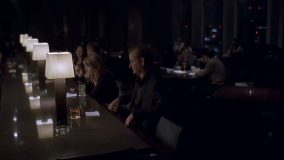LOST IN TRANSLATION, DIR. SOFIA COPPOLA (2003)
Tokyo, Japan
Lost in Translation is an American comedy shot by Sofia Coppola in 2003. The story tells of two wounded souls from America who meet in Tokyo – the neglected young wife of a photographer and the washed-up movie star shooting a TV commercial – finding an odd solace and pensive freedom to live their lives. The movie is primarily set in Tokyo, Japan, plus somewhere in Kyoto. The first and most important spot is the Park Hyatt Tokyo Hotel located in Shinjuku. This is where the two characters meet, and the storyline happens. The second locations that come to people’s mind are the Japanese temples, where the female character Charlotte visit alone in the movie. Plus, a few sites that contain Japanese culture and entertainment elements.
Explicitly speaking, comparing the New York Bar situated on the 52nd floor of the hotel in the movie1 to its image in reality, there are a few differences. First of all, because of COVID-19, partitions are set in each table to maintain social distance and decrease contagion risk. This is considered a social influence. The other difference is that the long counter where Bob drinks Suntory whisky gets turned into an appetiser buffet 2 during lunchtime, whose business mode switches. This reflects that the development of the economy leads to people’s rising pursuit of living quality. Last but not least, the film terminology “disappearance” is utilised in this movie as well. The vast frescoes in the wall, which is obvious to be seen by customers in reality, disappear in the movie scenes. My speculation is that the atmosphere of footage will become more engaging without the disturbance of other unharmonised colours. In addition, the temples Charlotte visits, the restaurants they go to, and the karaoke bar in the movie show nearly identical appearances in reality.
 The movie scene
The movie scene

The buffet section at lunchtime

The partitions during COVID-19
As a whole, the hue tends to be cool most of the time, reflecting Bob and Charlotte’s gloomy mood in Japan. Due to the language problems, they feel solitary and exhausted in this Asian city, which also links closely to the movie’s title. In the beginning, the architecture in Shinjuku in high-key colour establishes a crowded and high-developed image of Tokyo, the same as the glorious hotel where the two characters live. After that, the tone colour of the movie switches to a shade hue. When Charlotte visits the two Buddhist temples, the cinematographer shows the view of her back, and her blonde hair is typically conspicuous. Her hair colour is a representation of Western identity, and this scene in the movie indicates a collision of Eastern and Western cultures. Simultaneously, a contrast between the considerable architecture and tiny people is also revealed to show the sense of loneliness under that situation. Despite the traditional architecture, modern entertainment then comes to people’s eyes. Karaoke Kan, where Charlotte and Bob sing with their Japanese friends, indicates youngsters’ everyday lives in Tokyo. Karaoke, a Japanese word that translates as “empty orchestra”—is everywhere in Tokyo, being one of the city’s favourite pastimes.3 A notable phenomenon in this movie is that the saturation level will become significantly higher as the characters’ moods get better. When they are enjoying the party, they feel not alone. In this movie, colour is an indication of the theme.

The contrast between Charlotte and traditional Buddhist architecture

When Bob sings in Karaoke Kan
Notes:
1,2 Joshua, Meyer. A Guide To the Best ‘Lost in Translation’ Spots in Tokyo. https://blog.gaijinpot.com/guide-best-lost-translation-spots-tokyo/#comments (accessed March 21, 2022)
3 Finding Japan In Lost In Translation. https://www.focusfeatures.com/article/film-locations_japan_lost-in-translation (accessed March 21, 2022)
Hu Junya, 3035918086
There is a consistent visual analysis of the film and application of concepts (e.g. use of colours and contrast). Focusing on just one or two key spaces could allow you to go deeper into your comparative analysis. For example, the section comparing the hotel restaurant in reality and in the film is done in greater detail. Can you clarify how the omission of the wall frescoes is linked to Abbas’ concept of disappearance? Your references could be cited more clearly (e.g. you could have directly included the references in the captions of your images).